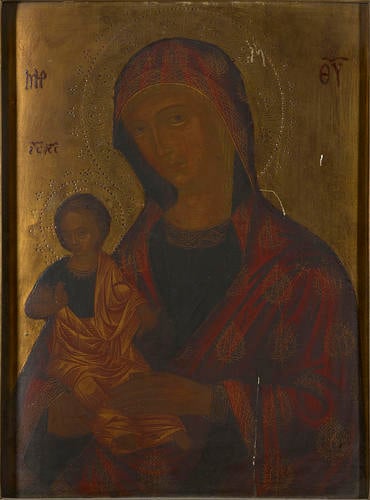Virgin and Child c.1400-1600
Panel | 38.6 x 28.0 cm (support, canvas/panel/stretcher external) | RCIN 403475
-
The term 'Byzantine' is used to refer to the art which emanated from the Eastern Christian Empire from the fourth century onwards, the capital of which was Byzantium or Constantinople, now Istanbul in Turkey. The term can often refer to a style, rather than a geographic place, and Byzantine painting is recognisable by its formulaic appearance, highly-stylised figures and rich colours.
This painting is a devotional image known as an icon, a window through which the viewer can interact with the holy subjects within. The Virgin acts as an intercessor here, mediating between the infant Christ and the viewer, to whom she presents her holy child as the way to Salvation. Her head is subtly inclined towards him in a sign of motherly affection. Jesus, who raises his hand in blessing, is dressed in an undergarment known in Greek as a chiton, along with the draped robe know as a himation. He holds a rotulus, a scroll of the written word rolled around a central rod. These items are all attributes of classical philosophers, adopted from ancient Greek art. Rather than being depicted as a baby here, Christ is presented as the embodiment of the eternal Word (Logos) of God, in the form of a man.
Like many others of its kind, the format of this painting derives from a venerated Byzantine icon known as the Virgin Hodegetria, which translates as 'she who points the way'. The miraculous wooden panel became the subject of legend, and was much written about, re-produced and speculated upon from the eleventh century onwards. The icon came to be attributed to the hand of Saint Luke, and was housed in the Monastery of the Hodegon in Constantinople, made famous for its miraculous spring waters which cured blindness.
Icons depict a sacred and infinite presence, and so resist any reference to a set time or place. Here, the gold background removes the Virgin and Child from an everyday, earthly reality. Their haloes are created through a network of patterns and holes, incised and punched directly into the gold leaf background.
Before passing to Prince Albert, this Virgin and Child was formerly in the possession of his relative, the German collector Prince Ludwig Kraft Ernst von Oettingen-Wallerstein. As recognised by Gustav Friedrich Waagen, in his descriptive catalogue of Oettingen-Wallerstein's collection (1854), the sensitive and naturalistic depiction of the Virgin's delicate hands and face perhaps suggests that this artist had links not only with the Byzantine tradition, but also with that of Italy.
Provenance
One of the group of Byzantine works from the 77 paintings belonging to Prince Ludwig von Oettingen-Wallerstein (1791-1870); these were first offered to Prince Albert in 1847 as security for a loan and came into his possession by default (no 3 in Waagen’s catalogue of 1854); 25 of them were accepted by the National Gallery in 1863.
-
Creator(s)
(artist) -
Medium and techniques
Panel
Measurements
38.6 x 28.0 cm (support, canvas/panel/stretcher external)
59.0 x 49.1 x 2.6 cm (frame, external)
Category
Object type(s)
Subject(s)
Alternative title(s)
Salvator Mundi








